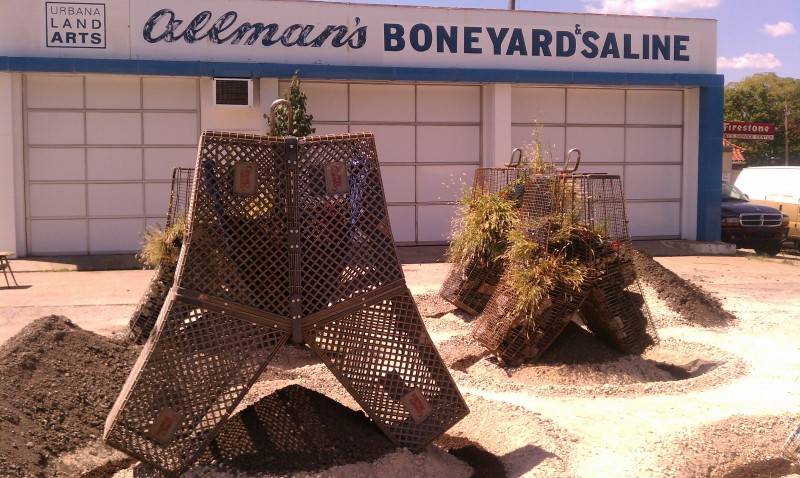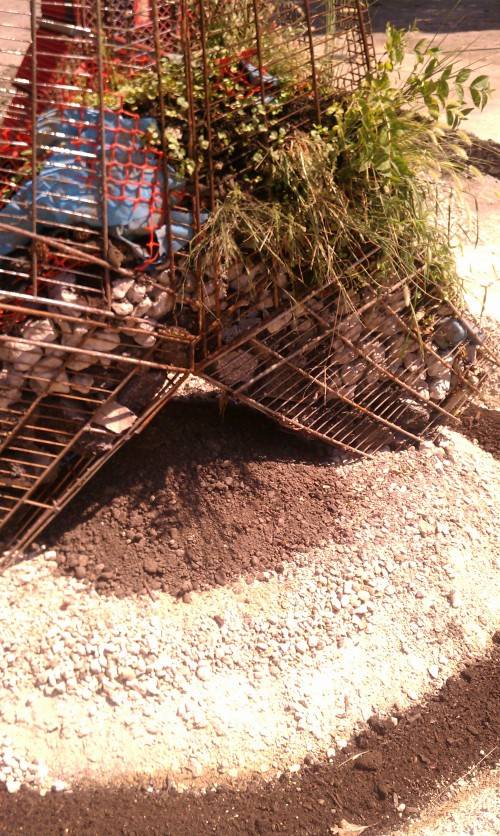
What’s in a shopping cart? Quite a lot, as it turns out.
This Friday and Saturday, U of I Landscape Architecture students Evan Blondell and Chris Carl will present an exhibition entitled “Allman’s Boneyard & Saline,” to be held at the former Allman’s Garage at the split of Springfield and Main just west of downtown Urbana. The installation features 28 shopping carts salvaged from a section of the Boneyard and Saline Creeks between downtown Urbana and High Cross Road.
The duo are raising money through Kickstarter to document their project through the creation of a project atlas, and they’re well on their way to their goal of $1,200. Check out the excellent video which accompanies the campaign:
Blondell and Carl received a $2,000 grant from the Urbana Public Arts Commission to begin their work, which paid for supplies to recover the carts for their exhibition. “We made a [canoe] trip to St. Joseph, an 11 or 12 mile trip out there, and when the water’s low it’s a little challenging, but you can all the way there, and all the way to the Salt Fork, and the Vermilion, and as far as you want to go,” Blondell said. “We brought a GPS out with us, and we ended up marking 56 shopping carts on that 11-mile trip. Then, we decided that we wanted to work just within a two to three mile area, to High Cross Road, and within that two to three mile stretch, we found 52 carts. So, our numbers were a little off, because there were still all the rest. We still go out there occasionally, and we missed several.”
Blondell is thrilled with the location of the exhibit.. “Lisa Sell is the daughter of Carl Allman, who passed away a few years ago, so she has the building and she’s been trying to sell it for a little while, and just hasn’t had luck yet doing so,” he explained. “So she loaned us the building; we showed her our renderings of our idea for the show, and she loved it, and she let us use it for a month.”
But their plans don’t stop there. Blondell continued, “But we really want to keep the space and turn it into what we’re calling Urbana Land Arts — this collective of landscape architects and designers that are doing land-based kind of work. She also likes that idea, so maybe in the future we can work out a rental agreement or something. That’s the idea, so these might stay here for a while. That would be pretty cool if they could.”
 The pair hope that this exhibition demonstrates their hands-on approach to landscape architecture. “The way we found [the carts] out in the creek, they were catching all this material,” Blondell noted. “Some of them were so buried, we had to use a hand winch and just take several hours sometimes. We’d say to ourselves, ‘Why are you out here doing this?’ but it all seemed worthwhile. We felt the need to go out there and clean up everything because it was such a disaster, but this project wasn’t really necessarily about cleaning the Boneyard and the Saline. It was more of a practice that we want to embrace as landscape architects, really getting out there and getting away from the computers, getting out and seeing the material and doing stuff with it.”
The pair hope that this exhibition demonstrates their hands-on approach to landscape architecture. “The way we found [the carts] out in the creek, they were catching all this material,” Blondell noted. “Some of them were so buried, we had to use a hand winch and just take several hours sometimes. We’d say to ourselves, ‘Why are you out here doing this?’ but it all seemed worthwhile. We felt the need to go out there and clean up everything because it was such a disaster, but this project wasn’t really necessarily about cleaning the Boneyard and the Saline. It was more of a practice that we want to embrace as landscape architects, really getting out there and getting away from the computers, getting out and seeing the material and doing stuff with it.”
Blondell is sensitive to the connection between shopping carts and homelessness, which they observed firsthand on the site of a former encampment in north Urbana which they excavated. “There was a large homeless establishment [there] 20 years ago or so,” he explained. “It was there for quite a while, and then eventually the city pushed everyone out, and that’s where the largest concentration of the shopping carts were.”
Along with the outdoor installation, there will also be an indoor accompaniment this weekend. “We’ll have this screen [inside the garage building] and potentially another one that we’re attaching to the beam and projecting videos on that we took out there,” Blondell said. “They won’t really show the process, but just more atmospheric sort of things, because I don’t think people really get down there and check it out. It’s actually really beautiful. There’s tons of wildlife out there, it’s funny, because a lot of it’s considered invasive, like honeysuckle, and carp, and then there’s also owls and herons and fish in essentially a drainage ditch, so it’s nice. It’s like a second nature.”
Photos by Justine Bursoni.








